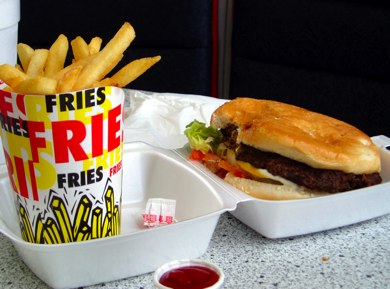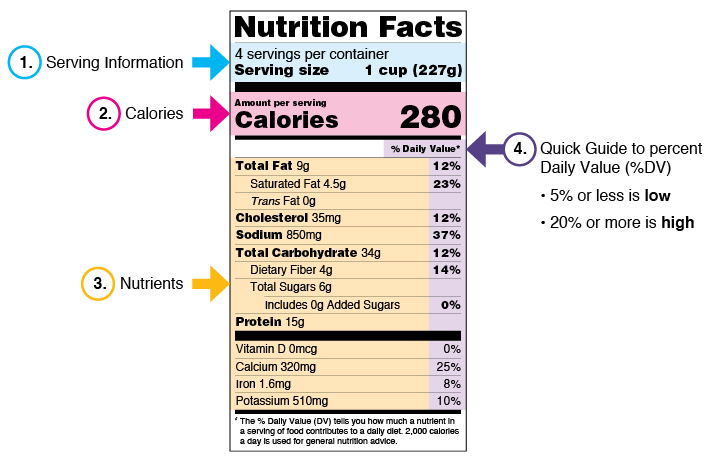



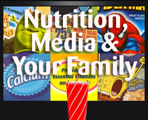
Where’s the Fruit?
Where’s the fruit? Notice how the front of
the box has pictures of fruit and the name of
the cereal is “Swirled Berries?” Look at the
ingredients on the food label—do you see any
fruit listed? Nope! Not a one!
Swirled Berries is not the only example of a product that is supposed to be offering fruit as a major ingredient.
The next time you choose a fruit snack or other product supposedly giving you lots of fruit, check out how much fruit it actually contains before putting it in your shopping cart. Read this article by the Center for Science in the Public Interest about another of the many culprits who use the old fruit fraud message to sell their product.
LINK
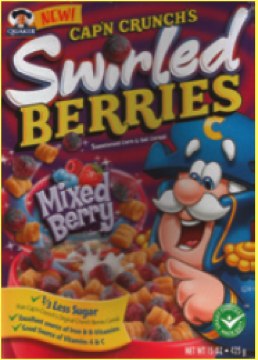
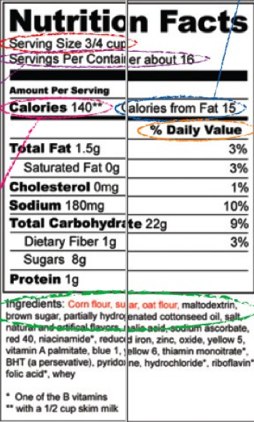
Swirled Berries is not the only example of a product that is supposed to be offering fruit as a major ingredient.
The next time you choose a fruit snack or other product supposedly giving you lots of fruit, check out how much fruit it actually contains before putting it in your shopping cart. Read this article by the Center for Science in the Public Interest about another of the many culprits who use the old fruit fraud message to sell their product.
LINK


Reading food labels
Sugar and Added Sugars
Just because the “Swirled Berries” box says
“1/3 less sugar” does not mean this product
is automatically healthy!
An Interesting Fact:
In the mid-1980s, several products removed the word "sugar" from their name. Sugar Smacks became Honey Smacks, and Super Sugar Crisp became Super Golden Crisp, to name just two. But the levels of sugar in the cereals have remained about the same.
The bad news is that Consumer Reports rated 23 of the top 27 cereals marketed to children as only Good or Fair for nutrition. LINK There is at least as much sugar in a serving of Kellogg's Honey Smacks and 10 other rated cereals as there is in a glazed doughnut from Dunkin’ Donuts. Two cereals, Kellogg's Honey Smacks and Post Golden Crisp, are more than 50 percent sugar (by weight) and nine are at least 40 percent sugar.
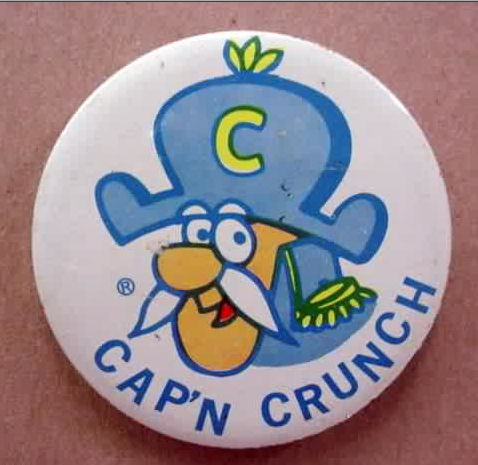
An Interesting Fact:
In the mid-1980s, several products removed the word "sugar" from their name. Sugar Smacks became Honey Smacks, and Super Sugar Crisp became Super Golden Crisp, to name just two. But the levels of sugar in the cereals have remained about the same.
The bad news is that Consumer Reports rated 23 of the top 27 cereals marketed to children as only Good or Fair for nutrition. LINK There is at least as much sugar in a serving of Kellogg's Honey Smacks and 10 other rated cereals as there is in a glazed doughnut from Dunkin’ Donuts. Two cereals, Kellogg's Honey Smacks and Post Golden Crisp, are more than 50 percent sugar (by weight) and nine are at least 40 percent sugar.
Fat: Good, Bad and Very Bad
What’s Fat?
We know the term and know that we should limit it (at least the bad kind), but what exactly is fat and what’s the difference between the four types of fats:
The Good…the unsaturated!
Monounsaturated Fat
These are the good guys! They include foods such as olive, peanut, sesame and canola oils, and avocados. They are heart-healthy and may help lower cholesterol.
Polyunsaturated Fat
These are the most important for maintaining a healthy body. Polyunsaturated fats include corn, cottonseed, safflower, sunflower and soybean oils and fish oil.
They have also been shown to help reduce the risk of heart disease.
The Bad….Saturated Fat!
These are considered the “bad” fats because they can raise cholesterol, which can lead to heart disease. Saturated fats are found in meats, poultry, dairy products, such as whole milk and cheese, as well as in some vegetable oils, such as palm kernel oils (found in cookies, cakes, crackers, and other baked products).
The Very Bad ….Trans-Fatty Acids (Trans-fat)
This type of fat is the worst! Trans-fat is created when unsaturated fats undergo a manufacturing process called hydrogenation---when a liquid or semi-soft fat is transformed into a more solid state. They are dangerous because they act like saturated fats in the body and raise cholesterol.
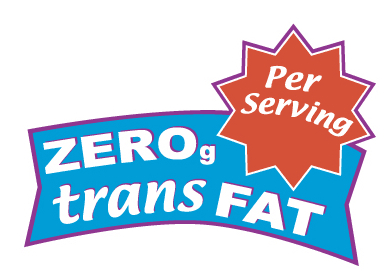
We know the term and know that we should limit it (at least the bad kind), but what exactly is fat and what’s the difference between the four types of fats:
The Good…the unsaturated!
Monounsaturated Fat
These are the good guys! They include foods such as olive, peanut, sesame and canola oils, and avocados. They are heart-healthy and may help lower cholesterol.
Polyunsaturated Fat
These are the most important for maintaining a healthy body. Polyunsaturated fats include corn, cottonseed, safflower, sunflower and soybean oils and fish oil.
They have also been shown to help reduce the risk of heart disease.
The Bad….Saturated Fat!
These are considered the “bad” fats because they can raise cholesterol, which can lead to heart disease. Saturated fats are found in meats, poultry, dairy products, such as whole milk and cheese, as well as in some vegetable oils, such as palm kernel oils (found in cookies, cakes, crackers, and other baked products).
The Very Bad ….Trans-Fatty Acids (Trans-fat)
This type of fat is the worst! Trans-fat is created when unsaturated fats undergo a manufacturing process called hydrogenation---when a liquid or semi-soft fat is transformed into a more solid state. They are dangerous because they act like saturated fats in the body and raise cholesterol.

Trans-fat free?
Although product packaging may tell us that a
product is trans-fat free, a product can
still meet the
legal definition
if it contains less than 0.5 grams of
trans-fat. Check out this article from
Consumer’s Report to learn about some
products that are said to have removed the
trans-fats.
https://www.consumerreports.org/cro/news/2015/03/what-does-no-trans-at-mean/index.htm
Fat and the 10 worst foods
Check out the list of 10 worst foods, based on the Center for Science in the Public Interest data.
Trans-fat use in the U.S.
For the latest word on what’s happening around the use of trans-fats in this country, check out the update from Center for Science in the Public Interest at:
Fat-free and Calories
Find out when fat-free isn’t always free. If you’re also trying to reduce calories while reducing fat, you may be surprised at the number of calories you’re getting in the fat-free versus the regular version of the same product. For more information on this important topic, see: HERE
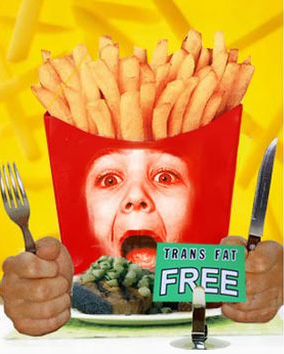
https://www.consumerreports.org/cro/news/2015/03/what-does-no-trans-at-mean/index.htm
Fat and the 10 worst foods
Check out the list of 10 worst foods, based on the Center for Science in the Public Interest data.
Trans-fat use in the U.S.
For the latest word on what’s happening around the use of trans-fats in this country, check out the update from Center for Science in the Public Interest at:
Fat-free and Calories
Find out when fat-free isn’t always free. If you’re also trying to reduce calories while reducing fat, you may be surprised at the number of calories you’re getting in the fat-free versus the regular version of the same product. For more information on this important topic, see: HERE

Carbohydrates
Just like our cars need fuel, our bodies also
need fuel. However the type of food (fuel) we
put into our bodies can make a big
difference.
A carbohydrate (or carbs as they are commonly known) is our body’s main source of fuel. There are two main types of carbohydrates---complex and simple. What is the difference?
Simple Carbohydrates
This type of carbohydrate can also be referred to as “simple sugars” because the fuel is in the form of sugar. Foods in this category include honey, jams/jellies, table sugar, cookies, syrup, candies, soft drinks, and also fruits. (Fruit Juices contain vitamins and minerals.)
Although fruit and fruit juices are considered “simple carbs,” these foods provide other important nutrients like fiber! Buy juices that are 100% fruit juice!
The calories contained in most simple carbohydrates offer little nutrition—they go straight to the blood; that’s where we get the term “sugar rush.”
Complex carbohydrates
Complex carbohydrates are the main fuel our bodies need. They come from plants, and include grains, vegetables, and beans.
Unlike simple carbohydrates, complex carbohydrates provide much more nutrition. The sugar is created during digestion, so it is released into the body at a slower rate. Click HERE to download a report on the Wonderful World of Whole Grains, written by Adrienne Dorf, MPH,RD,CD, Nutrition Consultant, Child Care Health Program, Public Health, Seattle and King County.
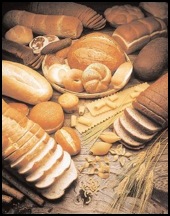
A carbohydrate (or carbs as they are commonly known) is our body’s main source of fuel. There are two main types of carbohydrates---complex and simple. What is the difference?
Simple Carbohydrates
This type of carbohydrate can also be referred to as “simple sugars” because the fuel is in the form of sugar. Foods in this category include honey, jams/jellies, table sugar, cookies, syrup, candies, soft drinks, and also fruits. (Fruit Juices contain vitamins and minerals.)
Although fruit and fruit juices are considered “simple carbs,” these foods provide other important nutrients like fiber! Buy juices that are 100% fruit juice!
The calories contained in most simple carbohydrates offer little nutrition—they go straight to the blood; that’s where we get the term “sugar rush.”
Complex carbohydrates
Complex carbohydrates are the main fuel our bodies need. They come from plants, and include grains, vegetables, and beans.
Unlike simple carbohydrates, complex carbohydrates provide much more nutrition. The sugar is created during digestion, so it is released into the body at a slower rate. Click HERE to download a report on the Wonderful World of Whole Grains, written by Adrienne Dorf, MPH,RD,CD, Nutrition Consultant, Child Care Health Program, Public Health, Seattle and King County.

Calories
A calorie is the amount of energy that food
provides.
One of the best ways to ensure our child’s
health is to make sure that the calories
he/she consumes come from wholesome and
nutritious foods!
Everything we eat contains calories—but don’t forget that not all calories are created equal! Have you ever heard of the term “empty calories?” Click HERE for an excellent resource: the online Calorie King Counter.
The Quality of the Carbs
The quality of food your child eats is very important! Sugary sweets such as cookies, candy and soda pop offer little in terms of nutrition---just plain old “empty calories.”
Notice how these two foods have the same number of calories but are very different in terms of their nutritional value?
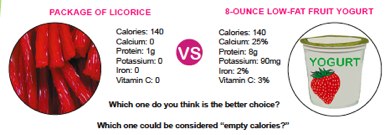
Package of Licorice 6-Ounce Low-Fat Fruit Yogurt
Calories: 140 Calories 140
Calcium: 0 Calcium 25%DV
Protein 1g Protein 8g
Potassium 0 Potassium 90mg
Iron 0 Iron 2% DV
Vitamin C 0 Vitamin C 3% DV
Which one do you think would be the better choice?
Which one could be considered “empty calories?”
Everything we eat contains calories—but don’t forget that not all calories are created equal! Have you ever heard of the term “empty calories?” Click HERE for an excellent resource: the online Calorie King Counter.
The Quality of the Carbs
The quality of food your child eats is very important! Sugary sweets such as cookies, candy and soda pop offer little in terms of nutrition---just plain old “empty calories.”
Notice how these two foods have the same number of calories but are very different in terms of their nutritional value?

Package of Licorice 6-Ounce Low-Fat Fruit Yogurt
Calories: 140 Calories 140
Calcium: 0 Calcium 25%DV
Protein 1g Protein 8g
Potassium 0 Potassium 90mg
Iron 0 Iron 2% DV
Vitamin C 0 Vitamin C 3% DV
Which one do you think would be the better choice?
Which one could be considered “empty calories?”
The Food Industry’s Role
Is the food industry truly the public’s
partner in prevention of the obesity epidemic
now sweeping this nation? While there have
been attempts by the food industry to claim
themselves as the public’s partner in
prevention, two well known health
professionals point out some of the conflicts
and pitfalls that the public needs to
consider. To learn more from Marion Nestle,
Ph.D., MPH and her colleague David Ludwig,
M.D. Ph.D., go
HERE

